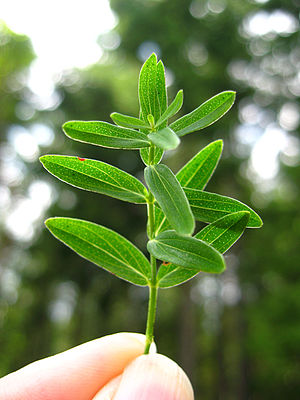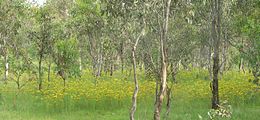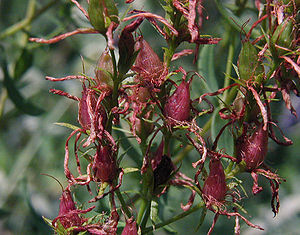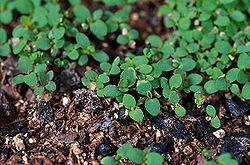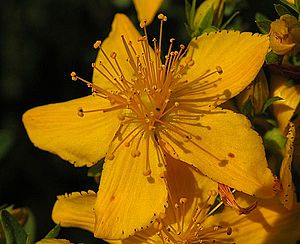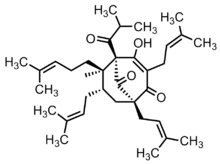- St John's wort
-
Hypericum perforatum
St John's wort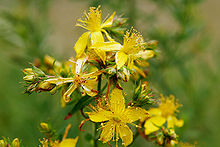
Scientific classification Kingdom: Plantae (unranked): Angiosperms (unranked): Eudicots (unranked): Rosids Order: Malpighiales Family: Hypericaceae Genus: Hypericum Species: H. perforatum Binomial name Hypericum perforatum
L.St John's wort (traditionally
 /sɪnʒənzˈwɜrt/ sin-jənz-wurt; now commonly
/sɪnʒənzˈwɜrt/ sin-jənz-wurt; now commonly  /ˈwɔrt/, as spelt) is the plant species Hypericum perforatum, and is also known as Tipton's Weed, Chase-devil, or Klamath weed.
/ˈwɔrt/, as spelt) is the plant species Hypericum perforatum, and is also known as Tipton's Weed, Chase-devil, or Klamath weed.With qualifiers, St John's wort is used to refer to any species of the genus Hypericum. Therefore, H. perforatum is sometimes called Common St John's wort to differentiate it. The species of Hypericum are classified in the Hypericaceae family, having previously been classified as Guttiferae or Clusiaceae.[1][2] Approximately 370 species of the genus Hypericum exist worldwide with a native geographical distribution including temperate and subtropical regions of North America, Europe, Turkey, Russia, India, China and Brazil.
St John's wort is widely known as an herbal treatment for depression.
Contents
Botanical description
Hypericum perforatum is a yellow-flowering, stoloniferous or sarmentose, perennial herb indigenous to Europe, which has been introduced to many temperate areas of the world and grows wild in many meadows. The common name comes from its traditional flowering and harvesting on St John's day, 24 June. The genus name Hypericum is derived from the Greek words hyper (above) and eikon (picture), in reference to the traditional use of the plant to ward off evil, by hanging plants over a religious icon in the house during St John's day. The species name perforatum refers to the presence of small oil glands in the leaves that look like windows, which can be seen when they are held against the light.
St John's wort is a perennial plant with extensive, creeping rhizomes. Its stems are erect, branched in the upper section, and can grow to 1 m high. It has opposing, stalkless, narrow, oblong leaves that are 12 mm long or slightly larger. The leaves are yellow-green in color, with transparent dots throughout the tissue and occasionally with a few black dots on the lower surface. Leaves exhibit obvious translucent dots when held up to the light, giving them a ‘perforated’ appearance, hence the plant's Latin name.
Its flowers measure up to 2.5 cm across, have five petals, and are colored bright yellow with conspicuous black dots. The flowers appear in broad cymes at the ends of the upper branches, between late Spring and early to mid Summer. The sepals are pointed, with glandular dots in the tissue. There are many stamens, which are united at the base into three bundles.
When flower buds (not the flowers themselves) or seed pods are crushed, a reddish/purple liquid is produced.
Ecology
St John’s wort reproduces both vegetatively and sexually. It thrives in areas with either a winter- or summer-dominant rainfall pattern; however, distribution is restricted by temperatures too low for seed germination or seedling survival. Altitudes greater than 1500 m, rainfall less than 500 mm, and a daily mean January temperature greater than 24 degrees C are considered limiting thresholds. Depending on environmental and climatic conditions, and rosette age, St John’s wort will alter growth form and habit to promote survival. Summer rains are particularly effective in allowing the plant to grow vegetatively, following defoliation by insects or grazing.
The seeds can persist for decades in the soil seed bank, germinating following disturbance.[3]
Invasive species
Although Hypericum perforatum is grown commercially in some regions of south east Europe, it is listed as a noxious weed in more than twenty countries and has introduced populations in South and North America, India, New Zealand, Australia, and South Africa.[3] In pastures, St John’s wort acts as both a toxic and invasive weed.[4] It replaces native plant communities and forage vegetation to the dominating extent of making productive land nonviable or becoming an invasive species in natural habitats and ecosystems. Ingestion by livestock can cause photosensitization, central nervous system depression, spontaneous abortion, and can lead to death. Effective herbicides for control of Hypericum include 2,4-D, picloram, and glyphosate. In western North America three beetles Chrysolina quadrigemina, Chrysolina hyperici and Agrilus hyperici have been introduced as biocontrol agents.
Medical uses
Depression treatment use
St John's wort is widely known as an herbal treatment for depression. In some countries, such as Germany, it is commonly prescribed for mild depression, especially in children and adolescents.[5]
A report from the Cochrane Review states,
The available evidence suggests that the Hypericum extracts tested in the included trials a) are superior to placebo in patients with major depression; b) are similarly effective as standard antidepressants; and c) have fewer side-effects than standard antidepressants.
There are two issues that complicate the interpretation of our findings:
1) While the influence of precision on study results in placebo-controlled trials is less pronounced in this updated version of our review compared to the previous version (Linde 2005a), results from more precise trials still show smaller effects over placebo than less precise trials.
2) Results from German-language countries are considerably more favourable for hypericum than trials from other countries.[6]Standardized extracts are generally available over the counter, though in some countries (such as the Republic of Ireland) a prescription is required. Extracts are usually in tablet or capsule form, and also in teabags and tinctures. Herbalists are more likely to use a fluid extract than a tincture. Hypericum was prescribed in ancient Greece,[citation needed] and it has been used ever since.
Dosage
Most studies of St. John's wort for treating depression used doses of 300 mg of an extract (standardized to 0.3 percent hypericin content) three times daily to achieve a therapeutic effect.[7]
Major depressive disorder
An analysis of twenty-nine clinical trials with more than five thousand patients was conducted by Cochrane Collaboration. The review concluded that extracts of St. John's wort were superior to placebo in patients with major depression. St John's wort had similar efficacy to standard antidepressants. The rate of side-effects was half that of newer SSRI antidepressants and one-fifth that of older tricyclic antidepressants.[6]
National Center for Complementary and Alternative Medicine (NCCAM) and other NIH-affiliated organizations hold that St John's wort has minimal or no effects beyond placebo in the treatment of major depression.[8][9] This conclusion is based primarily on one trial of 340 volunteers, with negative outcome conducted by NCCAM.[10] The authors of the study themselves, as well as several others, pointed out the low assay sensitivity of this study, and how only limited conclusions can be drawn from its results.[11][12] The same study also indicated that sertraline (Zoloft) has no positive effects vs. the same placebo.
St. John's wort has not been found to be effective for patients suffering from dysthymia, a less severe and more chronic variety of depression.[13]
Other medical uses
St. John's wort is being studied for effectiveness in the treatment of certain somatoform disorders. Results from the initial studies are mixed and still inconclusive; some research has found no effectiveness, other research has found a slight lightening of symptoms. Further study is needed and is being performed.
A a major constituent chemical, hyperforin, may be useful for treatment of alcoholism, although dosage, safety and efficacy have not been studied.[14][15] Hyperforin has also displayed antibacterial properties against gram-negative bacteria, although dosage, safety and efficacy has not been studied.[16] Traditional medicine has also employed lipophilic extracts from St. John's wort as a topical remedy for wounds, abrasions, burns, and muscle pain.[15] The positive effects that have been observed are generally attributed to hyperforin due to its possible antibacterial and anti-inflammatory effects.[15] For this reason hyperforin may be useful in the treatment of infected wounds and inflammatory skin diseases.[15] In response to hyperforin's incorporation into a new bath oil, a study to assess potential skin irritation was conducted which found good skin tolerance of St. John's Wort.[15]
A randomized controlled trial of St John's wort found no significant difference between it and placebo in the management of ADHD symptoms over eight weeks. However, the St. John's Wort extract used in the study, originally confirmed to contain 0.3% hypericin, was allowed to degrade to levels of 0.13% hypericin and 0.14% hyperforin. Given that the level of hyperforin was not ascertained at the beginning of the study, and levels of both hyperforin and hypericin were well below that used in other studies, little can be determined based on this study alone.[17]
A research team from the Universidad Complutense de Madrid (UCM) published a study entitled, "Hypericum perforatum. Possible option against Parkinson's disease", which suggests that St John's wort has antioxidant active ingredients that could help reduce the neuronal degeneration caused by the disease.[18]
Recent evidence suggests that daily treatment with St. Johns wort may improve the most common physical and behavioural symptoms associated with premenstrual syndrome.[19]
St John's wort was found to be less effective than placebo, in a randomized, double-blind, placebo-controlled trial, for the treatment of irritable bowel syndrome.[20]
St. John's Wort alleviated age-related long-term memory impairment in rats.[21]
Adverse effects and drug interactions
St John's wort is generally well tolerated, with an adverse effect profile similar to placebo.[22] The most common adverse effects reported are gastrointestinal symptoms, dizziness, confusion, tiredness and sedation.[23][24]
St John's wort may rarely cause photosensitivity. This can lead to visual sensitivity to light and to sunburns in situations that would not normally cause them.[22] Related to this, recent studies concluded that the extract reacts with light, both visible and ultraviolet, to produce free radicals, molecules that can damage the cells of the body. These can react with vital proteins in the eye that, if damaged, precipitate out, causing cataracts.[25] This finding is contradicted by the results of another recent study, which found that St. John's wort inhibits free radical production in both cell-free and human vascular tissue, revealing antioxidant properties of the compound. [26]
Women who use the contraceptive implant Implanon are advised not to take St John’s Wort as it reduces the implant's effectiveness.[citation needed]
Pharmacokinetic interactions
St John's wort has been shown to cause multiple drug interactions through induction of the cytochrome P450 enzyme CYP3A4, but also CYP2C9. This results in the increased metabolism of those drugs, resulting in decreased concentration and clinical effect. [27] The principal constituents thought to be responsible are hyperforin and amentoflavone.
St. John's wort also has been shown to cause drug interactions through the induction of the P-glycoprotein (P-gp) efflux transporter. Increased P-gp expression results in decreased absorption and increased clearance of those drugs, which leads to lower clinical concentrations and efficacy.[28]
Examples of drugs causing clinically-significant interactions with St John's wort Class Drugs antiretrovirals non-nucleoside reverse transcriptase inhibitors, protease inhibitors benzodiazepines alprazolam, midazolam hormonal contraception combined oral contraceptives immunosuppressants calcineurin inhibitors, cyclosporine, tacrolimus antiarrhythmics amiodarone, flecainide, mexiletine beta-blockers metoprolol, carvedilol calcium channel blockers verapamil, diltiazem, amlodipine statins (cholesterol-reducing medications) lovastatin, simvastatin, atorvastatin others digoxin, methadone, omeprazole, phenobarbital, theophylline, warfarin, levodopa, buprenorphine, irinotecan Reference: Rossi, 2005; Micromedex For a complete list, see CYP3A4 ligands and CYP2C9 ligands. For further updating on interactions and appropriate management, see Herbological.com – St John's Wort Interactions table.
Pharmacodynamic interactions
St John's wort may also contribute to serotonin syndrome, a potentially life-threatening adverse drug reaction, in combination with other drugs that may elevate 5-HT (serotonin) levels in the central nervous system (CNS).[29]
Drugs that may contribute to serotonin syndrome with St John's wort Class Drugs Antidepressants MAOIs, TCAs, SSRIs, SNRIs, mirtazapine Opioids tramadol, meperidine (pethidine), dextromethorphan CNS stimulants phentermine, diethylpropion, amphetamines, sibutramine, cocaine 5-HT1 agonists triptans Psychedelic drugs methylenedioxymethamphetamine (MDMA), lysergic acid diethylamide (LSD), psilocybin/psilocin Others selegiline, tryptophan, buspirone, lithium, linezolid, 5-HTP Reference: Rossi, 2005 Detection in body fluids
Hypericin, pseudohypericin, and hyperforin may be quantitated in plasma as confirmation of usage and to estimate the dosage. These three active substituents have plasma elimination half-lives within a range of 15–60 hours in humans. None of the three has been detected in urine specimens.[30]
Chemical composition
Contains a high concentration of Melatonin. Herb and flowers contain various polyphenols: flavonoids (rutin, hyperoside, isoquercetin, quercitrin, quercetin, I3,II8-biapigenin, amentoflavone, astilbin, miquelianin), phenolic acids (chlorogenic acid, 3-O-coumaroylquinic acid), and various naphtodianthrones: (hypericin, pseudohypericin, protohypericin, protopseudohypericin), phloroglucinols (hyperforin, adhyperforin). The naphthodianthrones hypericin and pseudohypericin along with the phloroglucinol derivative hyperforin are thought to be the active components.[31][32][33] It also contains essential oils composed mainly of sesquiterpenes.
Pharmacology
The exact mechanism by which St John's wort functions is unclear and subject to conjecture. The St John's wort mechanism is believed to involve inhibition of serotonin (5-HT) reuptake, much like the conventional selective serotonin reuptake inhibitor (SSRI) antidepressants.[34] The major active antidepressive constituents in St John's wort are thought to be hyperforin and hypericin, although other biologically active constituents present, for example, flavonoids and tannins, may also be involved.[35][36][37]
Some believe that hyperforin is the major constituent responsible for antidepressant activity, and it has been shown to inhibit the uptake of 5-HT, dopamine, and noradrenaline. Hyperforin also has affinity for GABA and glutamate receptors.[36] On the other hand, an hyperforin-free extract of St John's wort (Ze 117 – Remotiv) may still have significant antidepressive effects.[38][39]
Livestock – forage poisoning
Clinical signs
In large doses, St John's wort is poisonous to grazing livestock (cattle, sheep, goats, horses).[4] Behavioural signs of poisoning are general restlessness and skin irritation. Restlessness is often indicated by pawing of the ground, headshaking, head rubbing, and occasional hindlimb weakness with knuckling over, panting, confusion, and depression. Mania and hyperactivity may also result, including running in circles until exhausted. Observations of thick wort infestations by Australian graziers include the appearance of circular patches giving hillsides a ‘crop circle’ appearance, it is presumed, from this phenomenon. Animals typically seek shade and have reduced appetite. Hypersensitivity to water has been noted, and convulsions may occur following a knock to the head. Although general aversion to water is noted, some may seek water for relief.
Severe skin irritation is physically apparent, with reddening of non-pigmented and unprotected areas. This subsequently leads to itch and rubbing, followed by further inflammation, exudation, and scab formation. Lesions and inflammation that occur are said to resemble the conditions seen in foot and mouth disease. Sheep have been observed to have face swelling, dermatitis, and wool falling off due to rubbing. Lactating animals may cease or have reduced milk production; pregnant animals may abort. Lesions on udders are often apparent. Horses may show signs of anorexia, depression (with a comatose state), dilated pupils, and injected conjunctiva.
Early diagnosis
Increased respiration and heart rate is typically observed while one of the early signs of St John’s wort poisoning is an abnormal increase in body temperature. Affected animals will lose weight, or fail to gain weight; young animals are more affected than old animals. In severe cases death may occur, as a direct result of starvation, or because of secondary disease or septicaemia of lesions. Some affected animals may accidentally drown. Poor performance of suckling lambs (pigmented and non-pigmented) has been noted, suggesting a reduction in the milk production, or the transmission of a toxin in the milk.
Photosensitisation
Most clinical signs in animals are caused by photosensitisation.[40] Plants may induce either primary or secondary photosensitisation:
- primary photosensitisation directly from chemicals contained in ingested plants
- secondary photosensitisation from plant-associated damage to the liver.
Araya and Ford (1981) explored changes in liver function and concluded there was no evidence of Hypericum-related effect on the excretory capacity of the liver, or any interference was minimal and temporary. However, evidence of liver damage in blood plasma has been found at high and long rates of dosage.
Photosensitisation causes skin inflammation by a mechanism involving a pigment or photodynamic compound, which when activated by a certain wavelength of light leads to oxidation reactions in vivo. This leads to lesions of tissue, particularly noticeable on and around parts of skin exposed to light. Lightly covered or poorly pigmented areas are most conspicuous. Removal of affected animals from sunlight results in reduced symptoms of poisoning.
Other uses
Hypericum perforatum was also used by Native Americans internally as an abortifacient and externally as an anti-inflammatory, astringent, and antiseptic.[citation needed]
St. John's wort's has long been used as a herbal tea.[citation needed]
St. John's wort is also a common flavoring agent in Japanese udon noodles.
The flowers and stems of Hypericum perforatum have been used to produce red and yellow dyes.[citation needed]
Gardens
Hypericum perforatum is a popular groundcover type of ornamental plant used in gardens, including drought tolerant landscaping.
See also
- Dietary supplement
- EU Food supplements directive
- List of plants poisonous to equines
References
- ^ "Hypericum perforatum data sheet at the Royal Horticultural Society". http://apps.rhs.org.uk/plantselector/plant?plantid=1004. Retrieved 2011-03-24.
- ^ "#914: Hypericum frondosum - Floridata.com". http://www.floridata.com/ref/H/hype_fro.cfm. Retrieved 2008-11-02.
- ^ a b "SPECIES: Hypericum perforatum". Fire Effects Information System. http://www.invasive.org/weedcd/pdfs/feis/Hypericumperforatum.pdf.
- ^ a b St John's wort
- ^ Fegert JM, Kölch M, Zito JM, Glaeske G, Janhsen K (2006). "Antidepressant use in children and adolescents in Germany". J Child Adolesc Psychopharmacol 16 (1–2): 197–206. doi:10.1089/cap.2006.16.197. PMID 16553540.
- ^ a b Linde K, Berner MM, Kriston L (2008). Linde, Klaus. ed. "St John's wort for major depression". Cochrane Database Syst Rev (4): CD000448. doi:10.1002/14651858.CD000448.pub3. PMID 18843608.
- ^ http://depression.emedtv.com/st.-john%27s-wort/st.-john%27s-wort-dosage.html
- ^ St John's Wort and Depression NCCAM on St John's wort and depression]
- ^ How is depression detected and treated? NIMH on depression, including a section on St John's wort
- ^ Hypericum Depression Trial Study Group (April 2002). "Effect of Hypericum perforatum (St John's wort) in major depressive disorder: a randomized controlled trial". JAMA 287 (14): 1807–14. doi:10.1001/jama.287.14.1807. PMID 11939866. http://jama.ama-assn.org/cgi/pmidlookup?view=long&pmid=11939866.
- ^ Kupfer DJ, Frank E (April 2002). "Placebo in clinical trials for depression: complexity and necessity". JAMA 287 (14): 1853–4. doi:10.1001/jama.287.14.1853. PMID 11939872. http://jama.ama-assn.org/cgi/pmidlookup?view=long&pmid=11939872.
- ^ Spielmans GI (2002). "St John's wort and depression". JAMA 288 (4): 446–7; author reply 448–9. doi:10.1001/jama.288.4.446. PMID 12132963.
- ^ Randløv C, Mehlsen J, Thomsen CF, Hedman C, von Fircks H, Winther K (March 2006). "The efficacy of St. John's Wort in patients with minor depressive symptoms or dysthymia—a double-blind placebo-controlled study". Phytomedicine 13 (4): 215–21. doi:10.1016/j.phymed.2005.11.006. PMID 16423519.
- ^ Kumar V, Mdzinarishvili A, Kiewert C, et al. (September 2006). "NMDA receptor-antagonistic properties of hyperforin, a constituent of St. John's Wort". J. Pharmacol. Sci. 102 (1): 47–54. doi:10.1254/jphs.FP0060378. PMID 16936454. http://joi.jlc.jst.go.jp/JST.JSTAGE/jphs/FP0060378?from=PubMed.
- ^ a b c d e Reutera, J.; C. Huykea, H. Scheuvensa, M. Plochc, K. Neumannd, T. Jakobb, C.M. Schemppa (2008). "Skin tolerance of a new bath oil containing St. John's wort extract". Skin pharmacology and physiology 21 (6): 306-311.
- ^ Cecchini C, Cresci A, Coman MM, et al. (June 2007). "Antimicrobial activity of seven hypericum entities from central Italy". Planta Med. 73 (6): 564–6. doi:10.1055/s-2007-967198. PMID 17516331.
- ^ Weber W, Vander Stoep A, McCarty RL, Weiss NS, Biederman J, McClellan J (June 2008). "A Randomized Placebo Controlled Trial Of Hypericum perforatum For Attention Deficit Hyperactivity Disorder In Children And Adolescents". JAMA 299 (22): 2633–41. doi:10.1001/jama.299.22.2633. PMC 2587403. PMID 18544723. http://www.pubmedcentral.nih.gov/articlerender.fcgi?tool=pmcentrez&artid=2587403.
- ^ http://www.sciencedaily.com/releases/2009/05/090511181252.htm
- ^ Canning S, Waterman M, Orsi N, Ayres J, Simpson N, Dye L (March 2010). "The efficacy of Hypericum perforatum (St John's wort) for the treatment of premenstrual syndrome: a randomized, double-blind, placebo-controlled trial". CNS Drugs 24 (3): 207–25. doi:10.2165/11530120-000000000-00000. PMID 20155996.
- ^ Saito YA, Rey E, Almazar-Elder AE, Harmsen WS, Zinsmeister AR, Locke GR, Talley NJ (January 2010). "A randomized, double-blind, placebo-controlled trial of St John's wort for treating irritable bowel syndrome". Am. J. Gastroenterol. 105 (1): 170–7. doi:10.1038/ajg.2009.577. PMID 19809408.
- ^ Trofimiuk E., Braszko J.J.,"Hypericum perforatum alleviates age-related forgetting in rats." Current Topics in Nutraceutical Research. 8 (2-3) (pp 103-107), 2010. August 2010.
- ^ a b Ernst E, Rand JI, Barnes J, Stevinson C (1998). "Adverse effects profile of the herbal antidepressant St. John's wort (Hypericum perforatum L.)". Eur J Clin Pharmacol 54 (8): 589–94. doi:10.1007/s002280050519. PMID 9860144.
- ^ Barnes J, Anderson LA, Phillipson JD (2002). Herbal Medicines: A guide for healthcare professionals (2 ed.) London: Pharmaceutical Press. ISBN 0-85369-474-5.
- ^ Parker V, Wong AH, Boon HS, Seeman MV (February 2001). "Adverse reactions to St John's Wort". Can J Psychiatry 46 (1): 77–9. PMID 11221494.
- ^ Schey KL, Patat S, Chignell CF, Datillo M, Wang RH, Roberts JE (August 2000). "Photooxidation of lens alpha-crystallin by hypericin (active ingredient in St. John's Wort)". Photochem. Photobiol. 72 (2): 200–3. doi:10.1562/0031-8655(2000)072<0200:POLCBH>2.0.CO;2. PMID 10946573. http://onlinelibrary.wiley.com/resolve/openurl?genre=article&sid=nlm:pubmed&issn=0031-8655&date=2000&volume=72&issue=2&spage=200.
- ^ Hunt EJ, Lester CE, Lester EA, Tackett RL. (June 2001). "Effect of St. John's wort on free radical production". Life Sci. 69 (2): 181–90. doi:10.1016/S0024-3205(01)01102-X. PMID 11441908. http://www.ncbi.nlm.nih.gov/pubmed/11441908?genre=article&sid=nlm:lifesci&issn=11441908&date=2001&volume=69&issue=2&spage=181.
- ^ Markus Wenk, Liliane Todesco, and Stephan Krähenbühl, Effect of St John's wort on the activities of CYP1A2, CYP3A4, CYP2D6, N-acetyltransferase 2, and xanthine oxidase in healthy males and females; Br J Clin Pharmacol. 2004 April; 57(4): 495–499.
- ^ Gurley BJ, Swain A, Williams DK, Barone G, Battu SK (July 2008). "Gauging the clinical significance of P-glycoprotein-mediated herb-drug interactions: Comparative effects of St. John's wort, echinacea, clarithromycin, and rifampin on digoxin pharmacokinetics". Mol Nutr Food Res 52 (7): 772–9. doi:10.1002/mnfr.200700081. PMC 2562898. PMID 18214850. http://www.pubmedcentral.nih.gov/articlerender.fcgi?tool=pmcentrez&artid=2562898.
- ^ Rossi S (Ed.) (2005). Australian Medicines Handbook 2005. Adelaide: Australian Medicines Handbook. ISBN 0-9578521-9-3.
- ^ R. Baselt, Disposition of Toxic Drugs and Chemicals in Man, 8th edition, Biomedical Publications, Foster City, CA, 2008, pp. 1445–1446.
- ^ Umek, A; Kreft, S; Kartnig, T; Heydel, B (1999). "Quantitative phytochemical analyses of six hypericum species growing in slovenia". Planta medica 65 (4): 388–90. doi:10.1055/s-2006-960798. PMID 17260265.
- ^ Tatsis, EC; Boeren, S; Exarchou, V; Troganis, AN; Vervoort, J; Gerothanassis, IP (2007). "Identification of the major constituents of Hypericum perforatum by LC/SPE/NMR and/or LC/MS". Phytochemistry 68 (3): 383–93. doi:10.1016/j.phytochem.2006.11.026. PMID 17196625.
- ^ Schwob I, Bessière JM, Viano J.Composition of the essential oils of Hypericum perforatum L. from southeastern France.C R Biol. 2002;325:781-5.
- ^ Leuner K, Kazanski V, Müller M, Essin K, Henke B, Gollasch M, Harteneck C, Müller WE (December 2007). "Hyperforin—a key constituent of St. John's wort specifically activates TRPC6 channels". FASEB J. 21 (14): 4101–11. doi:10.1096/fj.07-8110com. PMID 17666455.
- ^ Nahrstedt A, Butterweck V (September 1997). "Biologically active and other chemical constituents of the herb of Hypericum perforatum L". Pharmacopsychiatry 30 Suppl 2: 129–34. doi:10.1055/s-2007-979533. PMID 9342774.
- ^ a b Butterweck V (2003). "Mechanism of action of St John's wort in depression : what is known?". CNS Drugs 17 (8): 539–62. doi:10.2165/00023210-200317080-00001. PMID 12775192. http://content.wkhealth.com/linkback/openurl?issn=1172-7047&volume=17&issue=8&spage=539.
- ^ Müller WE (February 2003). "Current St John's wort research from mode of action to clinical efficacy". Pharmacol. Res. 47 (2): 101–9. doi:10.1016/S1043-6618(02)00266-9. PMID 12543057. http://linkinghub.elsevier.com/retrieve/pii/S1043661802002669.
- ^ Woelk H (September 2000). "Comparison of St John's wort and imipramine for treating depression: randomised controlled trial". BMJ 321 (7260): 536–9. doi:10.1136/bmj.321.7260.536. PMC 27467. PMID 10968813. http://bmj.com/cgi/pmidlookup?view=long&pmid=10968813.
- ^ Schrader E (March 2000). "Equivalence of St John's wort extract (Ze 117) and fluoxetine: a randomized, controlled study in mild-moderate depression". Int Clin Psychopharmacol 15 (2): 61–8. doi:10.1097/00004850-200015020-00001. PMID 10759336.
- ^ St John's wort effects on animals
Further reading
- British Herbal Medicine Association Scientific Committee (1983). British Herbal Pharmacopoeia. West Yorkshire: British Herbal Medicine Association. ISBN 0-903032-07-4
- Müller, Walter (2005). St. John's Wort and its Active Principles in Depression and Anxiety. Basel: Birkhäuser. doi:10.1007/b137619. ISBN 978-3-7643-6160-0. http://www.springerlink.com/content/gl7841.
External links
- Barrett S (2000). "St. John's Wort". http://www.quackwatch.org/01QuackeryRelatedTopics/DSH/stjohn.html. Retrieved 2009-03-08.
- "St. John's wort: MedlinePlus Supplements". U.S. National Library of Medicine. http://www.nlm.nih.gov/medlineplus/druginfo/natural/patient-stjohnswort.html. Retrieved 2009-10-07.
- Species Profile- St. Johnswort (Hypericum perforatum), National Invasive Species Information Center, United States National Agricultural Library. Lists general information and resources for St. Johnswort.
- St. Johns Wort video podcast by Canadian Pharmacist Dean Elbe, PharmD, BCPP
Categories:- Hypericum
- Flora of Europe
- Flora of Estonia
- Flora of the United Kingdom
- Garden plants of Europe
- Invasive plant species in California
- Traditional Native American medical plants
- Abortifacients
- Antidepressants
- Medicinal plants
- Monoamine oxidase inhibitors
Wikimedia Foundation. 2010.

